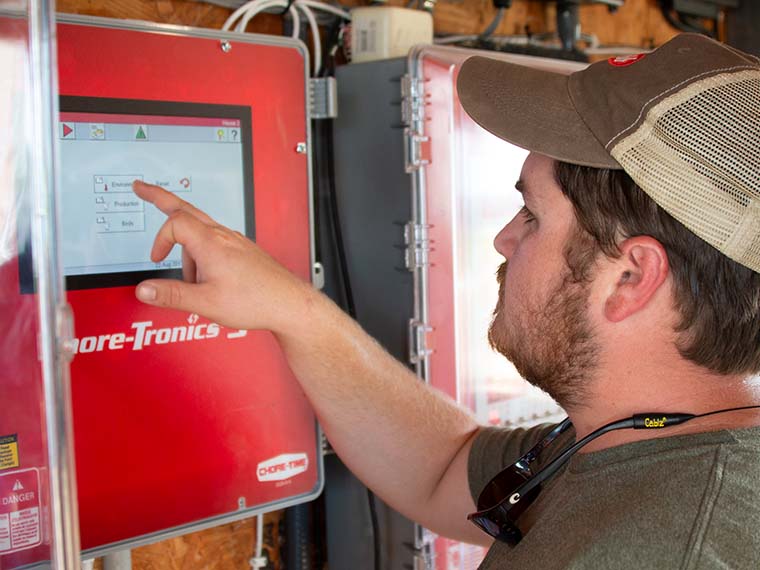The information presented on this page may be dated. It may refer to situations which have changed or people who are no longer affiliated with the university. It is archived as part of Mississippi State University's history.
A severe storm is moving through the area. The lights flicker and then go out. As you reach for a flashlight, your smart phone alerts you to electrical failure at your poultry house, some 20 miles away. Fortunately, you have an automated poultry house, and the power supply is automatically switched to a backup generator.
The scenario above doesn't seem unrealistic or out of the ordinary given current trends. In today's world, there are smart phones and homes, autonomous cars, and a host of other technologies powered by artificial intelligence and designed to make life easier.
This new computing power is also a driving force in agriculture, as livestock and row-crop farmers incorporate precision agriculture, with all of the tools and data it provides.
As precision agriculture grows, the need for trained professionals to hit the ground running is paramount. A new Mississippi State University partnership with Chore-Time®, Wadsworth Control Systems, and the USDA, is designed to prepare students for the future.
Aptly named Future Grower Technologies™, the partnership allows students to manage large food production systems through augmented reality. It is one facet of a multi-pronged approach to the university's leadership in precision agriculture technologies.
The partners provide the latest technologies used in agricultural production systems.
Chore-Time is a division of Chore Time Brock, a leading global designer, manufacturer, and marketer of agricultural systems and solutions. Owned by Warren Buffett, the company has environmental control systems for poultry, hogs, egg production, equine, and grain industries.
Wadsworth Control Systems develops greenhouse automation systems, including climate controls, curtain systems, and vent automation. Founded in Colorado, the company was the first to design and build greenhouse automation products in the U.S.
Virtual Grower or VG3 is a USDA-developed decision support tool for greenhouse systems managed by Dr. Jennifer Boldt. The software was designed to help greenhouse growers determine heating costs with simulations. The tool allows users to predict crop growth, assist in scheduling, make real-time predictions of energy use, and see the impact of supplemental lighting on plant growth and development.
The partnership formed with these companies will allow students in the MSU College of Agriculture and Life Sciences to learn valuable lessons about managing large farm productions from the comfort of the classroom.
"Students will have a simulated farm, whether it be a chicken house or a greenhouse, and will design their crop or livestock production system, determine when they need the crop to be produced, determine the estimated cost, and then begin the crop," said Dr. Amelia Fox, precision agriculture instructor in the Department of Plant and Soil Sciences. "Much of the data used in the simulation is based on growth models already developed."
These augmented reality education tools for agricultural production allows students to make decisions and learn problem-solving, within the safety net of a virtual environment, Fox added.
The ambitious program is in its infancy, with numerous other features planned, however, poultry facilities in the Mississippi Agricultural and Forestry Experiment Station have already been equipped with Chore-Time environmental and feed controls.
The poultry complex, located on the MAFES H. H. Levick Animal Research Center, is used for research and teaching. The facilities are designed to mimic those in an industrial setting.
Tom Tabler, extension professor in the Department of Poultry Science, worked closely with Chore-Time on the installation. He noted the importance of this opportunity for students to work with the latest technology.
"This technology will allow our students to be trained on the most modern and up-to-date equipment in the industry," Tabler said. "These skills will make our graduates highly sought-after in the commercial broiler industry."
Future Grower Technologies will not only meet the needs of students, but will also become a powerful research tool.
When catastrophe strikes, the response of growers is critical to saving crops or livestock. Through Future Grower Technologies, scientists will be able to respond to events in a controlled environment. Wes Burger, associate director of MAFES, described the possibilities of the technology.
"This technology will allow scientists to develop different responses to natural disaster in a virtual controlled environment so that when a catastrophic event occurs, we will have a playbook to know the best actions to take and the impact of those decisions," Burger said. "This information will benefit our partners with data to pass on to their customers."
Not only will the technology assist growers and industry partners, development of the tool is a research project. Scientists and graduate students will incorporate numerous crop growth models developed by MAFES researchers. Programming current and future models into an augmented reality environment so that simulations can be accurate is paramount to the long-term viability of the program.
The possibilities of different parameters that can be put into the system to determine anticipated crop yields, harvest dates, and value of the crop, based on environmental variables, will provide scientists and farmers with priceless information.
Future Grower Technologies promises to be a valuable tool for scientists and the agricultural industry as a whole while helping to train the agricultural leaders of tomorrow.

